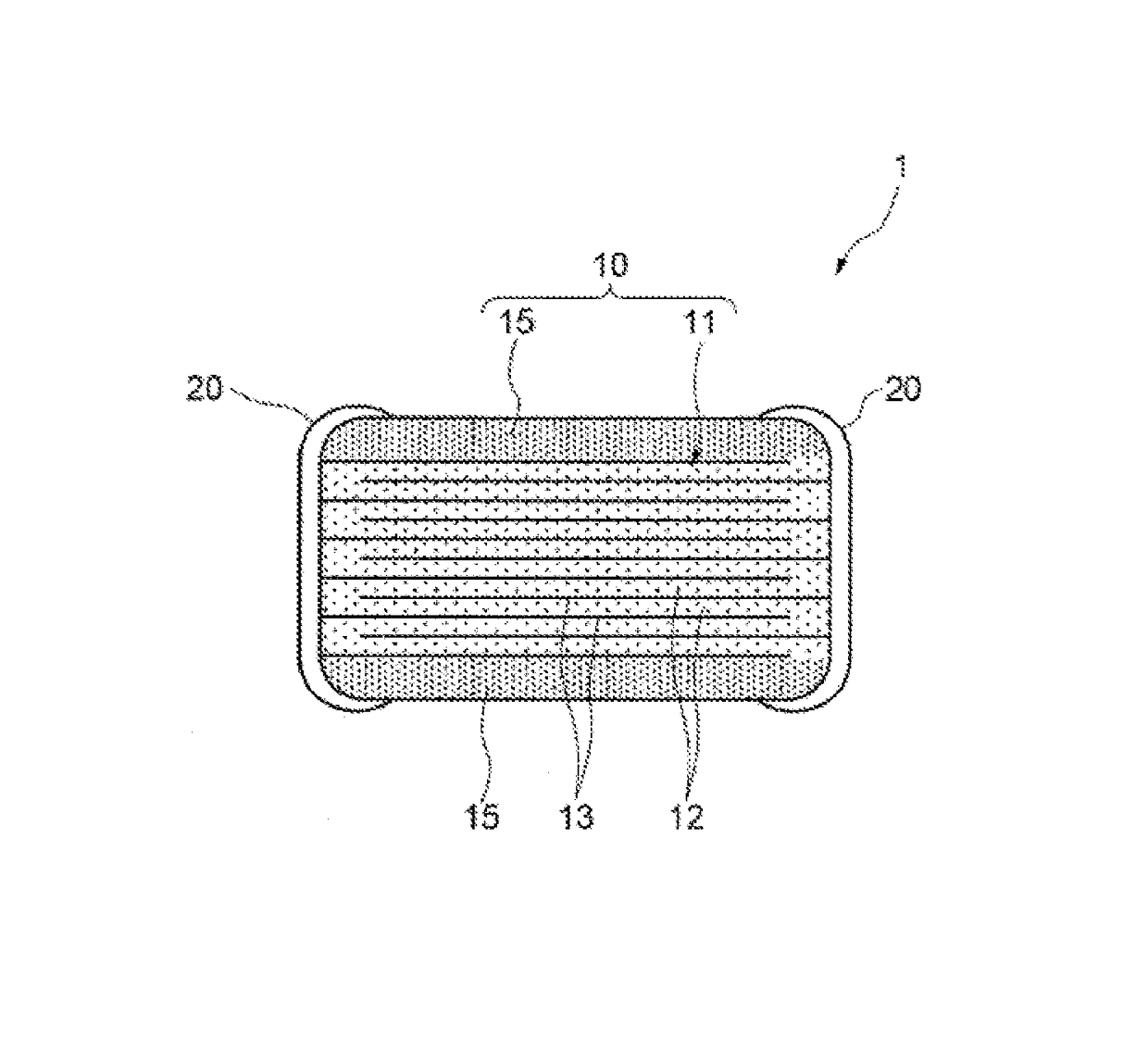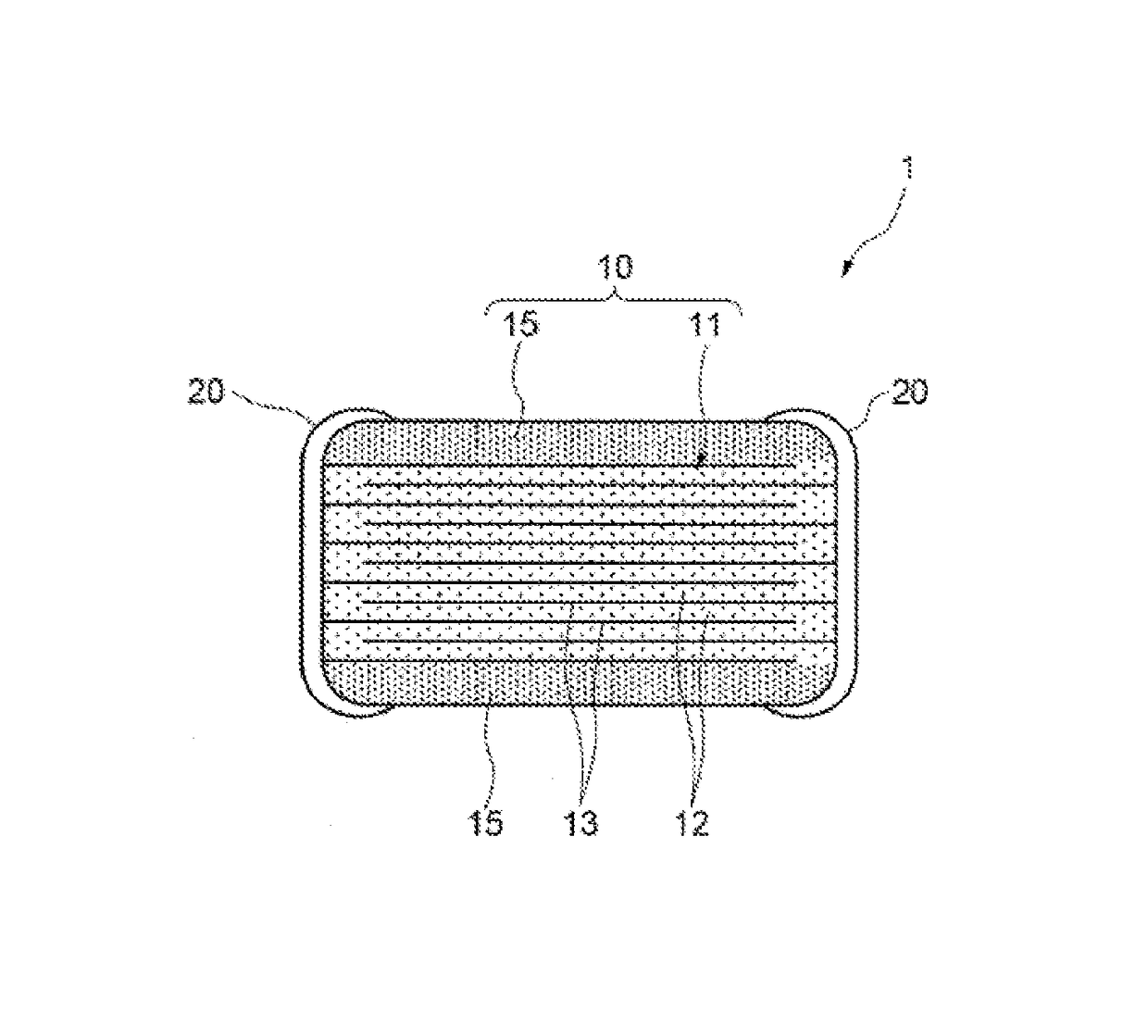Multilayer ceramic capacitor having dielectric layers containing ceramic grains constituted by primarily BaTiO3 and additionally Mo, Mn, R, and V/W
a multi-layer ceramic and ceramic capacitor technology, applied in the field of multi-layer ceramic capacitors, can solve problems such as magnification of leak current problems, and achieve the effect of improving service life characteristics
- Summary
- Abstract
- Description
- Claims
- Application Information
AI Technical Summary
Benefits of technology
Problems solved by technology
Method used
Image
Examples
example 1
[0071]BaCO3 (specific surface area 30 m2 / g) and TiO2 (specific surface area 50 m2 / g) were added to an aqueous solution of ion-exchanged water to which dispersant was added, in such a way that the Ba / Ti mol ratio became 1, and the obtained slurry was mixed / dispersed using a bead mill. The slurry was dried to remove water, and then tentatively sintered at 935° C. to synthesize BaTiO3 of 100 nm in average grain size based on a SEM photograph.
[0072]Next, the various additive materials were added at the ratios of MoO3=0.2 mol, (Ho2O3) / 2=0.75 mol, MnCO3=0.03 mol, WO3=0.184 mol, and SiO2=1.0 mol per 100 mol of BaTiO3 (all equivalent values as each chemical compound), after which solvent was added to obtain a slurry. PVB binder was added to the slurry and the slurry was applied on a PET film to a thickness of 1.0 μm to obtain a green sheet.
[0073]Next, a Ni conductive paste was printed on the green sheet as internal electrodes and this was used to produce a 400-layer multilayer ceramic capac...
example 2
[0080]A multilayer ceramic capacitor was produced in the same manner as in Example 1, except that MnCO3 was added by 0.02 mol (equivalent value) and (Ho2O3) / 2 was added by 0.50 mol (equivalent value). As a result, the average valence number of Mo became 4.52. The result of the high-temperature accelerated service life test of the multilayer ceramic capacitor was 470 minutes, and the current value after 30 seconds was 95 μA.
example 3
[0081]A multilayer ceramic capacitor was produced in the same manner as in Example 1, except that MnCO3 was added by 0.15 mol (equivalent value) and (Ho2O3) / 2 was added by 1.80 mol (equivalent value). As a result, the average valence number of Mo became 4.90. The result of the high-temperature accelerated service life test of the multilayer ceramic capacitor was 950 minutes, and the current value after 30 seconds was 85 μA.
PUM
| Property | Measurement | Unit |
|---|---|---|
| thickness | aaaaa | aaaaa |
| thick | aaaaa | aaaaa |
| thickness | aaaaa | aaaaa |
Abstract
Description
Claims
Application Information
 Login to View More
Login to View More - R&D
- Intellectual Property
- Life Sciences
- Materials
- Tech Scout
- Unparalleled Data Quality
- Higher Quality Content
- 60% Fewer Hallucinations
Browse by: Latest US Patents, China's latest patents, Technical Efficacy Thesaurus, Application Domain, Technology Topic, Popular Technical Reports.
© 2025 PatSnap. All rights reserved.Legal|Privacy policy|Modern Slavery Act Transparency Statement|Sitemap|About US| Contact US: help@patsnap.com


